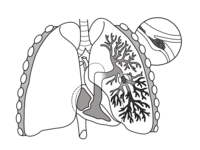
Photo from wikipedia
Abstract Bronchopulmonary dysplasia (BPD) is one of the most common pulmonary sequelae of extreme preterm birth, with long-lasting respiratory symptoms and reduced lung function. A reliable predictive tool of BPD… Click to show full abstract
Abstract Bronchopulmonary dysplasia (BPD) is one of the most common pulmonary sequelae of extreme preterm birth, with long-lasting respiratory symptoms and reduced lung function. A reliable predictive tool of BPD development is urgent and its search remains one of the major challenges for neonatologists approaching the upcoming arrival of possible new preventive therapies. Biomarkers, identifying an ongoing pathogenetic pathway, could allow both the selection of preterm infants with an evolving disease and potentially the therapeutic targets of the indicted pathogenesis. The “omic” sciences represent well-known promising tools for this objective. In this review, we resume the current laboratoristic, metabolomic, proteomic, and microbiomic evidence in the prediction of BPD. Key Points The early prediction of BPD development would allow the targeted implementation of new preventive therapies. BPD is a multifactorial disease consequently it is unlikely to find a single disease biomarker. “Omic” sciences offer a promising insight in BPD pathogenesis and its development's fingerprints.
Journal Title: American Journal of Perinatology
Year Published: 2022
Link to full text (if available)
Share on Social Media: Sign Up to like & get
recommendations!